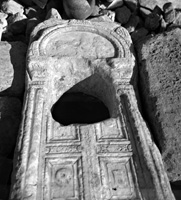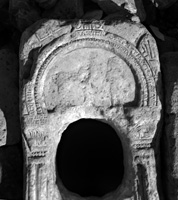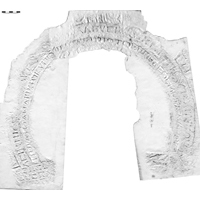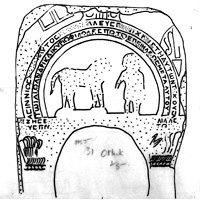 MAMA XI 138 (Pentapolis)
MAMA XI 138 (Pentapolis) 
Funerary doorstone of Philodespotos
- Type of monument:
- Funerary doorstone.
- Location:
- Otluk (Pentapolis): in a wall between the upper and lower villages; said to derive from Yanıkören. Now (2011) situated in the garden of the Hudaï Kaplıcası near Sandıklı.
- Description:
- Marble doorstone (Waelkens 1986: 162, Typ C Akmonia 1). Single door with four large panels; between upper and lower panels, a pair of small panels with concave sides (form no. 2) decorated with lozenges and nails at both ends. In upper left panel, spindle and distaff; in upper right panel, circular lock-plate; in lower left panel, door-knocker (or mirror?); in lower right panel, comb (?). Fluted pilasters to right and left; capitals decorated with palmettes. The upper part of the door is defaced by a circular hole; probable frame above the door. Archivolt with three fascias; in the tympanum, relief of man leading horse, deliberately defaced. Above the archivolt, corner and central (?) palmettes, diptychon at left. Inscription on the outer and middle fascias of the archivolt, continuing onto the frames above the pilasters and possibly on the tympanum or the frame above the door.
- Dimensions:
- Ht. 1.31; W. 0.63; Th. 0.22-0.27; letters 0.012-0.016.
- Record:
- Squeeze; drawing; MB notebook copy; photographs (1955/31).
- Publication:
- None.
- Date:
- c. AD 175-250 (doorstone type)
Ἀσίννι̣ος [- c.5-6 -]λυτος [καὶ Ἀχι]λλεὺς κ̣[αὶ] ἡ̣ χρη̣στὴ αὐτῶν τε̣κοῦσα
τῷ ἰδ̣ίῳ ἀνδρὶ καὶ κυρίῳ Φιλ̣οδ̣εσπότῳ, ἐπεὶ ἡδ̣έως μετὰ α̣ὐτοῦ
ἔζησε [ἔτεσι - - - - - - - - - - - - - - - - - - - - - - - - -] Α̣ΙΛΑΣ
[-] ΥΣΠ̣Ρ̣Ο̣[- - - - - - - - - - - - - - - - - - - - - - - - -] Ι̣Τ̣ΩΧΡΗ̣
5ΝΠΛΤ[- - - - - - - - - - - - - - - - - - - - - - - - - - - - - -] ΑΛΩ[-]
Asinius [...]lytos and Achilleus and their good mother, to her own sir husband Philodespotos, since she lived happily with him for [... years...].







The monument, recorded by Ballance at Otluk, now (2011) situated in the garden of the Hudaï Kaplıcası near Sandıklı, is said to have been brought from nearby Yanıkören (see also MAMA XI 153 [1955/30]). The underlined letters depend on a copy made between 1930 and 1954 by Calder’s friend Habip Zebir, a tinker living at Sandıklı (Calder 1956: 49), who saw the stone when it was still in use as a well-head.
For the spelling Ἀσίννιος with a geminate nu, see Salomies 2007: 66. His cognomen could be restored [Ἱππό]λυτος (the name is attested in Phrygia: MAMA IV 68 [Synnada]), were it not that the name seems a little short for the lacuna. For τεκοῦσα = ‘mother’, see the commentary to MAMA XI 123 (1955/93: Akmoneia). After τεκοῦσα, we would expect the woman’s name; this may have been inscribed on the abacus of the right-hand pilaster (compare the layout of two other doorstones of this type from Akmoneia, MAMA VI 288 [Waelkens 1986: 173, no.434] and MAMA XI 118 [1956/43]) or in the tympanum, although no trace of it is visible (compare MAMA XI 116 [1955/103]). Φιλοδέσποτος is a typical slave name (Robert 1969: 357-8). Τhe man was probably a freedman; cf. MAMA IV 336 (Eumeneia), where an ἀπελεύθερος is described as φιλοδέσποτος, ‘master-loving’.
The expression τῷ ἰδίῳ ἀνδρὶ καὶ κυρίῳ is also attested in SEG 28, 1041 (Nikomedeia); in both cases, the phrase is simply an expression of courtesy (‘sir husband’), synonymous with τῷ κυρίῳ ἀνδρί (Cameron 1939: 43; Robert, OMS III 1607-11; BE 1974, 573, 593). For the phrase ἡδέως ζῆν or συμβιοῦν as a means of describing a happy marriage, often of a stated number of years (Robert, OMS V 314-5), cf. IGUR II 786, συνβίῳ κλυκυτάτῳ, μεθ’ οὗ ἔζησα ἡδέως ἔτεσι ιδ΄; TAM V 1, 717 (Julia Gordos), τὴν γλυκυτάτην γυναῖκα συνβιώσασαν ἔτεσι λζ΄ ἀμάχως, ἡδέως, εὐσεβῶς; Körte 1900: 427, no.44 (Dorylaion), γυναι[κὶ γ]λυκυτάτῃ συνζη[σάσῃ] ἔτη · κ΄ · ἡδέως καὶ [ἀμ]έμπτως.